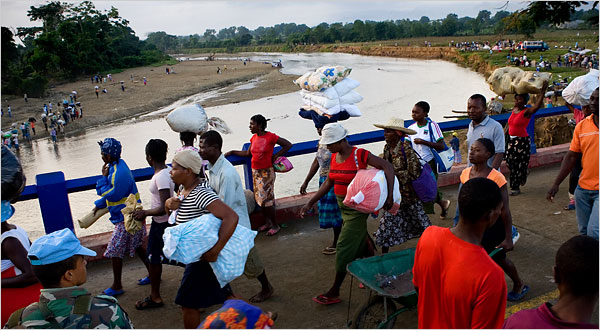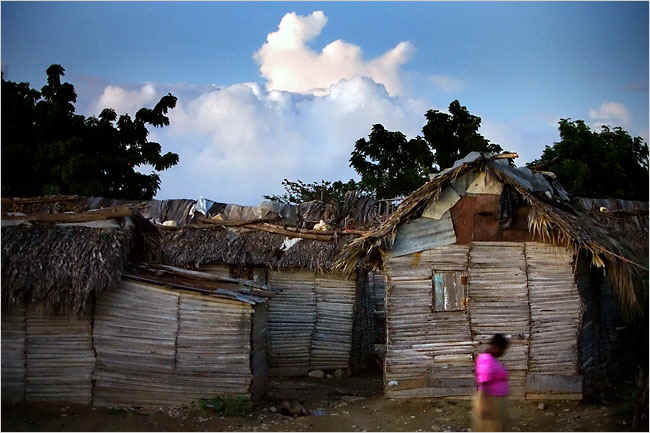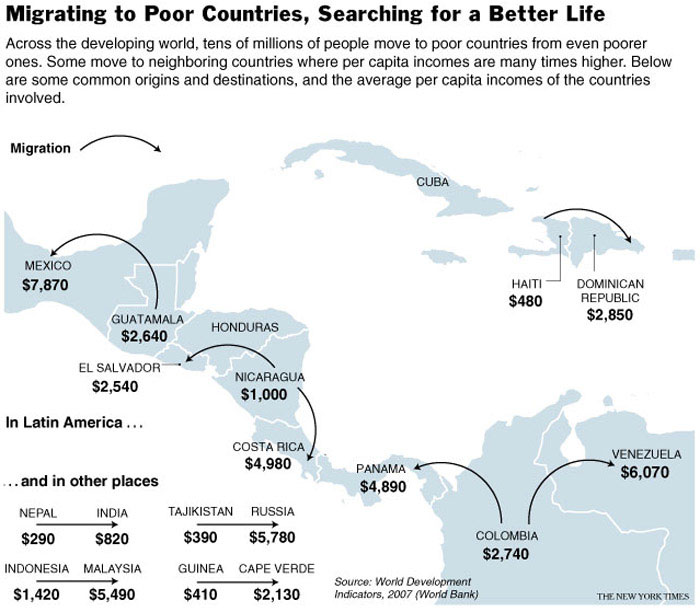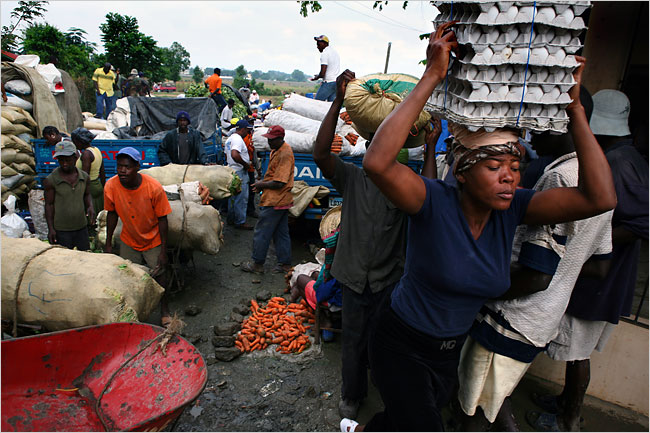| Want to send this page or a link to a friend? Click on mail at the top of this window. |
More Special Reports |
| Posted December 27, 2007 |
| A Global Trek to Poor Nations, From Poorer Ones |
 |
|
RICHARD PERRY/THE NEW YORK TIMES |
|
| Haitians cross a bridge linking their country and the Dominican Republic, where many Haitians buy necessities and seek work. |
By JASON DePARLE |
JUAN GÓMEZ, Dominican Republic — The scrap-wood shanties on a muddy hillside are a poor man’s promised land.
| The Overlooked Migration |
| This is the sixth in a series of |
| articles examining global |
| migration and its consequences. |
They have leaky roofs and dirt floors, with no lights or running water. But hundreds of Haitian migrants have risked their lives to come here and work the surrounding fields, and they are part of a global trend: migrants who move to poor countries from even poorer ones.
Among them is Anes Moises, 45, a dark-skinned man with flecks of gray hair, who has worked the Dominican banana fields for more than a decade, always illegally. Farm bosses pay him $5 a day and tell him that Haitians stink. Soldiers have called him a dark-skinned “devil” and deported him four times.
Still, with the average income in the Dominican Republic six times as much as in Haiti, Mr. Moises has answered each expulsion by hiring a smuggler to bribe the border guards and guide him back in.
“We are forced to come back here — not because we like it, but because we are poor,” he said. “When we cross the border, we are a little better off. We are able to buy shoes and maybe a chicken.”
Across the developing world, migrants move to other poor countries nearly as often as they move to rich ones. Yet their numbers and hardships are often overlooked.
They typically start poorer than migrants to rich countries, earn less money and are more likely to travel illegally, which raises the odds of abuse. They usually move to countries that offer migrants less legal protection and fewer services than wealthy nations do. Yet their earnings help sustain some of the poorest people on the globe.
There are 74 million “south to south” migrants, according to the World Bank, which uses the term to describe anyone moving from one developing country to another, regardless of geography. The bank estimates that they send home $18 billion to $55 billion a year. (The bank also estimates that 82 million migrants have moved “south to north,” or from poor countries to rich ones.)
Nicaraguans build Costa Rican buildings. Paraguayans pick Argentine crops. Nepalis dig Indian mines. Indonesians clean Malaysian homes. Farm hands from Burkina Faso tend the fields in Ivory Coast. Some save for more expensive journeys north, while others find the move from one poor land to another all they will ever afford. With rich countries tightening their borders, migration within the developing world is likely to grow.
“South to south migration is not only huge, it reaches a different class of people,” said Patricia Weiss Fagen, a researcher at Georgetown University. “These are very, very poor people sending money to even poorer people and they often reach very rural areas where most remittances don’t go.”
The Haitian migration to the Dominican Republic, its neighbor on the island of Hispaniola, has been large, longstanding and filled with strife. The Spanish-speaking Dominicans still refer angrily to a Haitian occupation that ended in 1844. The Creole-speaking Haitians point to 1937, when a Dominican massacre along the border is estimated to have taken the lives of tens of thousands of Haitians.
 |
RICHARD PERRY/THE NEW YORK TIMES |
| Juan Gómez is an encampment built by Haitians who crossed into the Dominican Republic in Search of work. |
Haitian workers started coming in large numbers nearly a century ago, as seasonal help in sugar cane fields. But many now work year-round on farms or urban construction sites, which raises their visibility and the chance for conflict. Estimates vary greatly, but Dominican officials put Haitian migrants at one million, or 11 percent of the population.
As Haitians see it, the problems go beyond hard work and low pay to the systemic violation of their rights. Dominicans profit from their labor, they say, but deny them work papers, deport them at will and discriminate on the belief that Haitians have darker skin.
“There is no justice here,” Mr. Moises said.
Dominicans often present themselves as generous neighbors of limited means, forced to bear the burden of Haiti’s failed state, indigence and epidemic disease. They say they offer Haitians jobs and health care — 30 percent of the public health budget is spent on Haitians, government officials say — while enduring lectures about human rights from countries far from the fray.
“Ay-yai-yai-yai,” said Gen. Adriano Silverio Rodríguez, the commander of a new border force, when describing how Americans would respond if they shared a border with a country as troubled as Haiti. “That wall they’re building — it would be longer and taller.”
Per capita income in the Dominican Republic is $2,850; in Haiti it is $480.
 |
The clash of civilizations can be seen along the Massacre River, a muddy, waist-deep waterway that divides them. On the Dominican side, Dajabón is a market town of 10,000 people, with paved streets, public utilities and a new Internet cafe. Its Haitian counterpart, Ouanaminthe, is seven or eight times as big, with no municipal lights or running water. The dirt roads are filled with trash and pigs.
 |
RICHARD PERRY/THE NEW YORK TIMES |
| Dajarbón, a Dominican border town, opens its gated bridge twice a week to allow Haitians to buy goods unvailable in their country. |
Twice a week, Dominicans open the bridge, and thousands of Haitians rush across to buy goods that are scarce on their side: eggs, nails, flour, concrete, carrots, salami, juice, cooking oil, chickens and plastic chairs. Guards patrol the area, trying to ensure the Haitians’ return.
Bribery and violence are common. In a case now before the Inter-American Commission on Human Rights, Dominican soldiers are accused of indiscriminately firing on a smuggler’s truck, killing six Haitians. Two dozen Haitians in a smuggler’s truck suffocated last year. Their bodies were dumped on the road.
| Unwritten Rules |
The village of Juan Gómez lies 35 miles east of the border, past three military checkpoints that search for illegal migrants. But its illegal migrants, like Mr. Moises, live in plain view. Their open presence points to the capricious unwritten rules: Haitians caught at the border are usually sent back, while those needed by employers are often left to stay, at least until someone objects.
“We do not intervene in the workplace,” said Carlos Amarante Baret, the Dominican immigration director. “We understand the needs of the agricultural sector.” He acknowledged that the situation “benefits the landowner.”
Gathered here at a small hilltop church squeezed among the shanties, the workers talked of the hardships they had fled and those they had encountered. Jacqueline Bayard said the threat of deportation left the workers powerless. Katline Auguste said the lack of legal papers had kept her from visiting her children in Haiti for three years.
Lorvil Seus said he lived in fear of vigilante violence, as in a famed incident in nearby Hatillo Palma, in which a Haitian pastor was killed — and 2,000 Haitians deported — after the murder of a Dominican woman. Reprisal killings spread, and three Haitians were burned to death near the capital, Santo Domingo.
Mr. Moises voiced gratitude as well as complaints, explaining that he had once walked from Haiti with his malarial daughter in his arms, and Dominican doctors had saved her. “We can only thank them because they helped us,” he said.
Dominican society, in his view, is complex. Some politicians want Haitians deported, he said, but employers “need us to work.” Poor Dominicans claim Haitians are stealing jobs, but refuse those jobs themselves. Officers sometimes order raids to curry political favor, he added, but low-paid soldiers want the Haitians around to extort bribes. “It’s a business they have,” he said. “We are living in their country,” he said.
“We have to take it.”
| Colliding Interests |
Dominican officials often say that the colliding interests that surround immigration are similar to those in the United States, but that poor countries like theirs have fewer resources to cope. Carlos Morales Troncoso, the Dominican foreign minister, said that the solution to the Haitians’ problems was to promote development in Haiti and urged the United States to do more. “The developed countries talk a lot about Haiti, but the necessary aid just doesn’t come,” he said. By providing jobs, he said, “we do more than the whole international community combined.”
Some south to south migrants are “pushed” by wars and political crises. Others are “pulled” by jobs and better wages. Some follow seasonal work. Some put down roots. Some countries — Argentina is one — have been quick to give amnesty to migrants. Others, including Nigeria and Indonesia, have subjected them to mass deportations.
Many countries simultaneously send and receive large migrations. One reason there are jobs for Haitians is that so many Dominicans have left for the United States. The president, Leonel Fernández, was largely reared in New York City.
That exposes what Dilip Ratha, an economist at the World Bank, calls a common double standard. “Many countries want good treatment for their own people abroad but they don’t treat immigrants well themselves,” he said.
Egyptian police officers killed 26 Sudanese migrants last year in an attack on their squatter camp. An Indian film star, Hritik Roshan, set off a deadly riot in Katmandu, Nepal, in 2000 when he was quoted as saying he “hated” the Nepalis. Costa Ricans sometimes deride Nicaraguans as “Nicas.” In 2005, two Rottweilers killed a Nicaraguan suspected of being a burglar, as an approving crowd watched. Jokes flooded the country, praising the dogs.
Still, Manuel Orozco of Inter-American Dialogue, a Washington research group, warned against viewing south to south migration solely in a negative light. He estimates that Haitians in the Dominican Republic send home $135 million a year.
“Destination countries benefit from foreign labor,” Mr. Orozco said, while migrants get jobs. The challenge, he said, is to create policies that “promote development for both countries, while protecting migrants and their families.”
“Just letting migration happen is not good enough,” he added.
The Dominican Republic has no such framework. This year alone, the conditions of its Haitians have been the focus of two documentary films, a photo exhibit in Paris and a United Nations investigation that found “a profound and entrenched problem of racism.”
| Who Is a Citizen? |
One battle now playing out involves the right to citizenship, which the Dominican Constitution promises to anyone born on Dominican soil except the children of diplomats and visitors “in transit.” But in 2005 the Supreme Court ruled that illegal immigrants were essentially in transit — though some lived in the country for decades — and therefore their children had no citizenship rights.
Critics say that the ruling conflicts with international law, including a decision by the Inter-American Court of Human Rights two months earlier. They also said the government was using it to deny papers to Dominicans of Haitian descent, impeding their ability to work, study and vote.
Nationalists are trying to get the anti-citizenship provisions written into the Constitution.
“We could have hundreds of thousands of so-called Dominican nationals who on cultural, emotional and political grounds would see themselves as Haitian,” said Pelegrín Castillo, a leading nationalist legislator. “Every day there are more Haitians in the Dominican Republic,” he added. “We are overwhelmed.”
For many Haitians, the journey ends where it began — in the muddy border town of Ouanaminthe, which receives scores of deported migrants each week. Most arrive penniless. Some sleep in City Hall.
Wesbert Sertil, 27, was among the unfortunates. Tired of hearing his in-laws complain that he could not feed his children, he borrowed $50 a year ago and boarded a smuggler’s truck. But the construction work he found was sporadic, and he sent money home just twice, totaling $90.
He was leaving work one day when military men asked for his papers. After a few days in a border-town jail, he was sleeping in abandoned houses, and asking a religious group for food.
His village was an eight-hour bus ride away, and the family that had urged him to go was unaware of his pending return. Smugglers approached him on the streets, but Mr. Sertil planned to use any money he could scrounge to buy a ticket home. “I got desperate and went to the Dominican Republic,” he said. “I’m not going back again.”
He noted that there were plenty of Haitians willing to take his place.
Copyright 2007 The New York Times Company. Reprinted from The New York Times, International, of Thursday, December 27, 2007.
| Wehaitians.com, the scholarly journal of democracy and human rights |
| More from wehaitians.com |